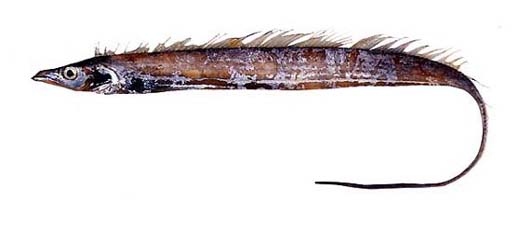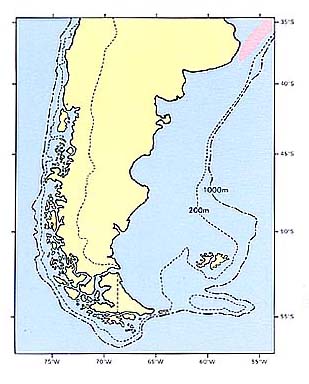タチウオ科
- HOME
- デジタル図鑑
- パタゴニア海域の重要水族
- 硬骨魚綱 スズキ目
- タチウオ科
タチウオ科(Trichiuridae)

110 タチウオ(Tachiuo)
Trichiurus lepturus Linnaeus, 1758
Largehead hairtail, Atlantic cutlassfish (En.); Poisson sabre (Fr.); Pez sable (Sp.); Sabre, Pez sable (Arg., Urg.); Peje espada (Urg.); Peixe espada(Br.)
タチオ,タチ(業界名)
特 徴:
背鰭120〜138軟条,胸鰭11軟条,鰓条骨数6,鰓耙数6〜9+12〜13=19〜21。全長に対する割合(%):体高は6.3〜7.2,体幅は1.9〜2.6,頭長は11.1〜11.2,眼径は2.0〜2.1,両眼間隔は1.7〜1.9,吻長は4.1〜4.3,上顎長は4.7〜5.1,胸鰭長は4.1〜4.3,胸鰭前長は12.3〜14.5,肛門前長は34.8〜36.7。体は著しく延長し,強く側扁する。腹鰭および腰骨がなく,尾部先端はひも状に延長,しばしば切断する。吻は強く突出し,先端は鋭くとがる。口は大きく,下顎は上顎より著しく突出する。上顎後端は眼の前縁下を越える。両顎歯は大きく鋭く,前部にある犬歯状歯の先端は鈎状,口蓋骨にも歯がある。眼は比較的大きく,頭部背縁外郭に接近して位置する。両眼間隔域はほぼ平坦。鰓蓋の下縁はやや凹む。背鰭は1基でよく発達し,後頭部から後方のほとんど全背面を占める。胸鰭は短く,吻長とほぼ同長。臀鰭は痕跡的で極めて小さな突起となって体表に現われているが,大型個体では肉質部に埋まる。体表に全く鱗はない。側線は体の前方で斜行し,体軸の下方に沿って尾部まで直走する。鰓耙はこぶ状で痕跡的。体は一様に銀白色で真珠様に輝くが,表皮は非常にはがれやすい。背鰭の縁辺部はわずかに暗色。
分 布:
本種は世界の熱帯・温帯域に広く分布する共通種で,アメリカ大西洋岸ではバージニア州北部からアルゼンチン北部までの陸棚上に分布する。アルゼンチン北部ではラプラタ河口沖の水深30〜50mから採集されたが,一般に水深100mまでの中底層に生息する。
備 考:
最大体長は1.5m。通常70cm(Vergara,1977)。産業的に重要な魚種であるが,食用魚としての評価は地域により異る。チリには分布しない。
(稲田伊史)
Material examined:
2 from Argentina (480-1017 mm TL), FSFL EM 46, 303.
Description:
D 120-138; P1 11; GR 6-9+12-13=19-21; BR 6.
HL 11.1-11.2% of TL; ED 2.0-2.1; BD 6.3-7,2; BW 1.9-2.6; SN 4.1-4.3; IO 1.7-1.9; UJ 4.7-5.1; P1L 4.1-4.3; PreAn 34.8-36.7.
Body very elongate and strongly compressed. Pelvic fin and girdle absent. Caudal fin absent, end of body tapering to a poiot (tip often broken and degenerated). Snout prominent and its tip strongly pointed. Mouth large; lower jaw projecting anterior to upper jaw; posterior end of upper jaw extending below anterior margin of eye. Teeth on both jaws large and pointed; teeth on anterior part fang-like, their tips hook-shaped in abults. Palatine also toothed. Eye relatively large, situated close to dorsal margin of head. Interorbital space almost flat. Lower hind margin of gill-cover concave. A single dorsal fin well developed, running from behind head almost to end of body; pectoral fin short and nearly equal to snout in length; anal fin reduced to minute spines buried in flesh in larger fish. Body entirely scaleless. Lateral line descending obliquely at anterior part of body, and running nearer to ventral profile. Gill-rakers knob-like and vestigial. Color of fresh body silvery with metallic reflections, but easily disappears; upper margin of dorsal fin dasky.
Distribution:
A cosmopolitan species usuglly found from surface up to 100 m depth in tropical and warm temperate waters. It is distributed on the continental shelf from northern Virginia to northern Argentina along east coasts of the American Continent. Two specimens were obtained from off La Plata River in our survey.
Remarks:
Maximum size 1.5 m, common to 70 cm (Vergara, 1977). Important commercial species throughout the world, abundant and commercially exploited in southern Atlantic (Parin and Bekker, 1973).
(Tadashi INADA)

Distribution of Trichiurus lepturus in Patagonia.